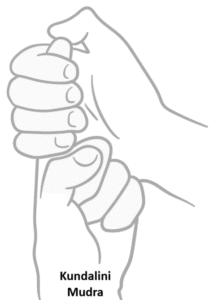Kundalini Mudrā
Introduction
Kundalini Mudrā is a symbolic yogic hand gesture designed to awaken, balance, and harmonize the Kundalini Shakti—the dormant spiritual energy located at the base of the spine. In yogic tradition, Kundalini represents the coiled serpent power that, when awakened, rises through the chakras to bring enlightenment and liberation (moksha).
This mudra is often practiced in meditation, Tantra, and Kundalini Yoga to channel sexual and creative energies into spiritual transformation.
Meaning
Sanskrit:
Kundalini = “coiled” (referring to the serpent energy at the root chakra).
Mudrā = gesture, seal, or symbolic action.
Thus, Kundalini Mudrā means “the gesture to awaken and direct the coiled energy.”
Symbolically, it represents the union of masculine (Shiva) and feminine (Shakti) principles, merging into spiritual wholeness.
How to Perform (Method of Practice)
Steps:
Sit comfortably in Sukhasana, Padmasana, or Vajrasana with a straight spine.
Hold both your hands in front of you in a loose fist.
Then, stretch the index finger of the left hand and pass it with the right hand, which is still stuck. Pass the finger from the bottom, that is, from pinky to thumb.
The grip on this position where the thumb-cushion of your right hand should rest on the tip of your left index finger.
The other fingers of your right hand will cover the left index finger, like a loose glove.
While doing this pose, pull your hands up to the lower abdomen.
Close the eyes, breathe deeply, and focus awareness on the Muladhara (Root Chakra).
Visualize energy rising upward through the spine with each breath.
Hold for 10–15 minutes, or longer in deep meditation.
Benefits
Physical Benefits
Stimulates sexual and reproductive health.
Harmonizes hormonal balance by activating the endocrine system.
Enhances vitality and stamina.
Supports energy flow through pelvic and abdominal organs.
Mental & Emotional Benefits
Reduces sexual frustration by redirecting libido into creative energy.
Balances emotional polarity (yin-yang, male-female, left-right brain).
Improves self-confidence, passion, and motivation.
Reduces stress and promotes inner calm.
Spiritual Benefits
Awakens Kundalini Shakti for spiritual progress.
Supports chakra alignment, especially Root and Sacral chakras.
Promotes union of Shiva (consciousness) and Shakti (energy).
Helps practitioners reach higher states of meditation and awareness.
Contraindications
Avoid if experiencing severe mental illness, psychosis, or extreme anxiety, as Kundalini awakening can intensify symptoms.
Not suitable for those with heart disease, high blood pressure, or epilepsy, unless guided by a teacher.
Should not be forced—Kundalini energy should awaken gradually and safely.
Pregnant women should avoid prolonged practice.
Anatomy & Physiology
Focuses on the pelvic floor, spine, and brain.
Activates Root Chakra (Muladhara) → regulating survival, stability, and grounding.
Stimulates Sacral Chakra (Svadhisthana) → governing sexuality, creativity, and emotions.
Physiologically affects the autonomic nervous system, balancing sympathetic and parasympathetic responses.
Kinesiology
The firm clasp of the hands symbolizes containment of energy.
The right index finger penetrating the left fist represents the union of opposites (male-female, solar-lunar, active-passive).
Creates muscular engagement in forearm and hand muscles, reinforcing focus and grounding.
Neurology
Stimulates limbic system (emotion, memory, motivation).
Activates hypothalamus-pituitary axis, enhancing hormonal regulation.
Promotes parasympathetic dominance, inducing calm yet alert awareness.
Encourages neuroplasticity, rewiring sexual energy toward creativity and spiritual growth.
Duration of Practice
Beginners: 5–10 minutes daily.
Intermediate: 15–30 minutes during meditation.
Advanced: Up to 1 hour with guidance in Kundalini practices.
Best practiced early morning (Brahma Muhurta) or before meditation.
Counter Mudra
Moola Bandha (Root Lock) – stabilizes energy during Kundalini awakening.
Yoni Mudra – balances and grounds excess energy.
Gyan Mudra – calms the mind and integrates awakened energy.
Conclusion
Kundalini Mudrā is a profound yogic practice for awakening inner energy, balancing sexuality, and channeling creative force into spiritual transformation. It symbolizes the sacred union of opposites, leading to wholeness and liberation. Practiced with awareness, discipline, and guidance, it harmonizes body, mind, and spirit, making it a powerful tool for both personal growth and spiritual awakening.
FAQ
Q1: Can Kundalini Mudra awaken energy suddenly?
Yes, it can, but awakening is usually gradual. Sudden awakening may cause imbalance if not guided.
Q2: Is it safe to practice daily?
Yes, but practice moderately and with grounding exercises like Pranayama or Gyan Mudra.
Q3: Does it increase sexual desire?
Initially it may heighten awareness, but the purpose is to transform sexual energy into higher consciousness.
Q4: Do I need a teacher for this mudra?
Beginners can practice safely for grounding, but advanced awakening should be guided by a trained teacher.
Q5: Can it be combined with mantra meditation?
Yes, mantras like Om Namah Shivaya or Sat Nam enhance Kundalini Mudra’s effects.
References
Swami Satyananda Saraswati – Kundalini Tantra.
Swami Niranjanananda – Prana and Pranayama.
Gertrud Hirschi – Mudras: Yoga in Your Hands.
Mallinson, James & Singleton, Mark – Roots of Yoga.
Lilian & Joseph Le Page – Mudras for Healing and Transformation.
